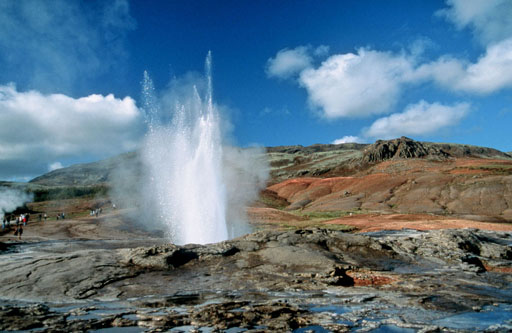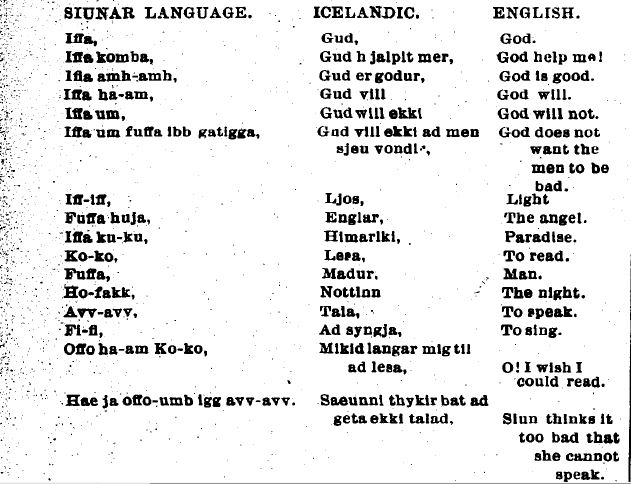Miss Johnson’s Siunar Language

The erupting “Great Geysir” in Haukadalur
I have a friend setting off shortly on a voyage to Iceland, land of fire and ice and polysyllabic place-names. So it seems appropriate that we look at an interesting person from Iceland who, as a child, developed her own language. Several caveats: this seems to be a single-source story reprinted long after the fact in a Spiritualist journal. What could possibly go wrong? I know next to nothing about Iceland except I am told that jam is eaten on nearly everything, some lava flows may be stopped by playing fire-hoses on them, and that elves still play an influential role in public works, so please bear with the misspellings and possible temporal and geographic misapprehensions of this story.
SIUNAR LANGUAGE.
Can persons be born with a language? If so, can they be born with a language different from their mother language?
These questions I was asked by a friend, who called my attention to an article in an Icelandic journal some months ago, telling me of a lady who died some years ago, who spoke a language different from all others known.
The following is an extract from a letter written by a man who knew Miss Siun Johnson for over thirty years. He says: Miss Siun Johnson was born at Illugastodum [Illugastadir?] in Hunavaths State about the beginning of the eighteenth century. She staid [sic] with her parents until she was twenty-five years old; then they died. She moved with her foster sister, Miss Maria Bjarnson, to Thorkelshill, in Wididal. Miss Bjarnson married Sigfus Bergmann Sigfusson, pastor of Felli in Skagafjord; [Skagafjörður?] with them she remained until they died, then she moved from there to the well-known student, Paul W. Vidalin and his wife Elinborg, and with them she remained to her death which occurred in her seventieth year.
Miss Johnson was seven years old when she began to speak; it happened one time when the children were down on the sea shore playing, gathering shells.
She did not agree with them and she began to speak this strange language. Her brothers and sisters were very quick learning her language, although she did not speak it fluently before she was ten years of age.
She was very intellectual although she never could learn our language. She had great respect for all that was religious, and was a true believer in the Lutheran faith. She was confirmed by the consent of the bishop, and her brother answered for her. She went to the communion and I dare say that she understood that better than many who can speak the language.
I knew Miss Johnson from the time I was born (in 1830), until I was thirty years old, I learned her language as quickly as my own and every Sunday I had to translate the gospel; she kept me busy with her questions.
The following is a list of words from her strange language. She had words for most everything she saw and heard. The wonder is that her language was so distinct from other languages:
Here I will paste in the table rather than transcribe:

She loved all that was good and beautiful, and wished all men to be good. She was very quick in learning all kinds of work, and very active in all her doings. She was always working, she could not be idle, she wished all things explained to her and she had an excellent memory and appreciated all good done to her, but was very revengeful if she was not treated right.
I remain, yours respectfully,
Baldvin Arason
There were different opinions in regard to this language. Many thought it was witchcraft; others thought it a wild language and that Miss Johnson was born with it.
I wish to hear the opinion of some of the good readers of The Journal in regard to this language.
P. Johnson .
Chicago, Ill.
Religio-Philosophical Journal 21 May 1892, p. 820
This has some parallels with those stories of twins who communicate in their own languages, except Miss Johnson was not a twin. The repetition of syllables suggests charismatic glossolalia. Tongue-in-cheek suggestion: was Miss Johnson perhaps an Icelandic shamaness? Any linguists in the audience who would like to comment? Do the place-names above make any sense? If I’m reading my sources correctly, Paul W. Vidalin [Páll Vídalín?] was a friend of the scholar Árni Magnússon. Or did he have a son? This is all very confusing because this 19th-century source on Miss Johnson (and it seems to be a sole source in English–I haven’t located the Icelandic journal) discusses her and her associates as contemporaries, while she was said to be born at the beginning of the 18th century. How, precisely, did she know someone born in 1830 for over thirty years when she died at age 70 unless there is a missprint in the article and she was actually born at the beginning of the 19th century?
Any other details of Miss Johnson’s life and language? Avv-avv to Chriswoodyard8 AT gmail.com
Chris Woodyard is the author of The Victorian Book of the Dead, The Ghost Wore Black, The Headless Horror, The Face in the Window, and the 7-volume Haunted Ohio series. She is also the chronicler of the adventures of that amiable murderess Mrs Daffodil in A Spot of Bother: Four Macabre Tales. The books are available in paperback and for Kindle. Indexes and fact sheets for all of these books may be found by searching hauntedohiobooks.com. Join her on FB at Haunted Ohio by Chris Woodyard or The Victorian Book of the Dead. And visit her new blog at The Victorian Book of the Dead.
